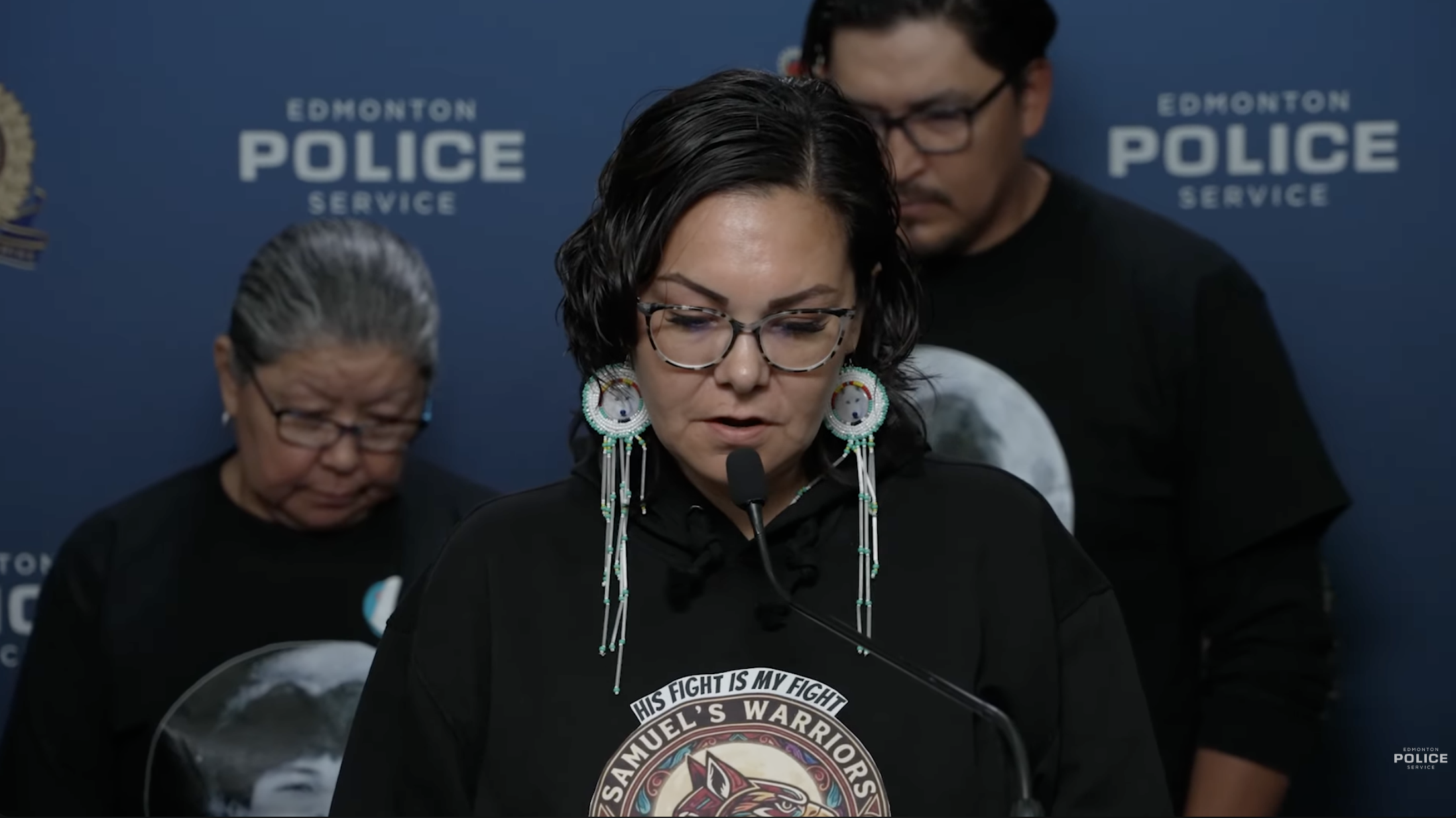‘One united purpose’: Sinixt, Secwépemc people paddle together amid contentious treaty news
‘Waterways have always been our way of connecting,’ says Stevey Seymour, who helped organize the week-long canoe journey on the waters of sn̓x̌ʷn̓tkʷítkʷ


A translation of this story in n̓səl̓xčin̓ is available here.
A week-long canoe journey along sn̓x̌ʷn̓tkʷítkʷ swift river (the Columbia River) brought Sinixt and Secwépemc people together — bonding as fellow salmon people and “neighbours since time immemorial.”
Out on the water, people from the two nations strengthened their relationships and historical ties in defiance of harmful colonial regimes, including a contentious decision that excluded the Sinixt from Columbia River Treaty renegotiations.
For many Sinixt people — who were falsely declared “extinct” in 1956 — the annual trip is an important way to assert their sovereignty and honour their ancestral waterways as the community continues to grapple with the effects of their attempted erasure.
The group from Sinixt and Secwépemc set off southbound on five canoes from skxikn̓ place going along the mountains (Revelstoke, B.C.) on June 14. They arrived at their destination — sx̌ʷnítkʷ (Kettle Falls, Washington) — in time for an annual salmon ceremony on National Indigenous Peoples Day.

Secwépemc paddler Dale Tomma served as skipper of the Skwlāx te SecwepemcúÍecw Little Shuswap Lake Band’s canoe during the journey.
“As salmon people, and neighbours since time immemorial, it was just natural for us to come and join and really welcome [the Sinixt] back into the homelands of the Upper Columbia where they’re from,” said Tomma.
For some Sinixt paddlers, it was their first time coming home to their lands north of the 49th parallel. Their ancestors faced multiple waves of the smallpox epidemic, and mining booms beginning in the 1890s displaced many Sinixt south of the border into the “U.S.,” where the government there forced them onto the Colville reservation.
In 1956, the government of “Canada” declared the Sinixt extinct. It wasn’t until 65 years later that a 2021 Supreme Court of Canada decision affirmed their rights to hunt and fish, allowing them to return.

The canoe journey is a way for the Sinixt to “pick up our pieces,” said Stevey Seymour, canoe journey organizer and executive director of the Inchelium Language and Culture Association, as she sat in a boat near ki’yamələp place of dead trees (Nelson).
Above her stood a rocky bluff coloured with red-ochre pictographs which she said were drawn by her Sinixt relatives long before Europeans arrived.
“People don’t know that in our stories, women actually grew from the ground, from the soil of this place, and so we feel our connection to this area,” Seymour said.
The forced removal and extinction declaration “caused a great deal of identity issues for us,” she added.
“We’ve had to fight tooth and nail for every song, for every memory, for every piece that we have.”
The canoe journey is part of remembering and reviving that Sinixt identity, providing a “vehicle to make those connections and rebuild those relationships” with neighbouring nations, she said.
“Waterways have always been our way of connecting.”

Sinixt canoe skipper Christian Haugen — who is also Spokane and Kalispel — sees paddling with members of neighbouring nations as a way to move beyond the divide-and-conquer tactics colonial governments have used to weaken Indigenous sovereignty.
“The canoe journey is a huge part in mending relationships between tribes,” he said.
“Ever since we started to be colonized there’s been the purpose of pitting us against each other, persuading these tribes, or luring them into these treaties, or [enticing them] to partner up and turn against our own people.”
Exclusion and competition remains a government stance. On June 8, one week before the canoe journey, the Sinixt received news that they had not only been excluded from negotiations to modernize the Columbia River Treaty, but were also denied a part in a revenue-sharing agreement between the B.C. government and First Nations.

“All of the Columbia River Treaty dams are in Sinixt territory,” said Shelly Boyd, territorial land advisor for the Colville Confederated Tribes.
She added that the original 1964 Columbia River Treaty was signed conveniently “at the same time that we were declared extinct.”
“I believe in my heart that [the declared extinction] was connected to the Columbia River Treaty,” she said.

“It doesn’t feel like it’s an accident,” added Seymour. “It’s very intentional. It’s very manipulative is what it feels like.”
The three neighbouring nations — Secwépemc, Ktunaxa, and Syilx Okanagan — were included in the discussions and will each receive five per cent of “Canada’s” revenue from the Columbia River Treaty dams going forward.
“We didn’t even get to sit at the table,” said Seymour, referring to the fact that “Canada’s” negotiating team included only the other three nations.
“Actually, they hid it from us. We had no idea it was even on the table.”

“Treaty negotiations are like a game of cards,” said Eileen Delehanty Pearkes, author of A River Captured: The Columbia River Treaty and Catastrophic Change.
“In the settler governance structure, treaty negotiations are conducted competitively with the cards not being shared.”
One of the reasons the cards weren’t shared with the Sinixt is the fact their territory is crossed by the international border, said Pearkes.
In competitive treaty negotiations involving two large colonial entities — the “U.S.” and “Canada” — the Sinixt, whose homelands are colonized by both nations, could have thrown off “the diplomatic dance between the two countries,” she said.
“To have Indigenous people with sovereignty on both sides of the border involved in negotiations would have, in the government’s view, created a deeply problematic situation.”

Another reason the Sinixt were excluded is their extinct status as of 2016, when treaty negotiations began, Pearkes added.
The precedent-setting 2021 Desautel case, affirming Sinixt rights to hunt and fish in “Canada,” confirmed the Sinixt’s continuing existence. Yet, government policies and positions are rigid and slow-moving.
Adding to the ball and chain of bureaucracy is the current land claims process with neighbouring tribes — another modern-day treaty process from which the Sinixt have been excluded. As a result, neighbouring nations are seeking to claim territory which Sinixt also claim title to.
Mark Underhill, the lawyer who argued for Sinixt rights to the top level of “Canada’s” court system, said one of the deep flaws in the land claims process is overlapping claims and the concept of “shared territory.”
On June 18, partway through the canoe journey, Boyd and Underhill spoke on a panel in ki’yamələp place of dead trees (Nelson), where they presented a collection of maps of Sinixt territory drawn by ethnographers in the 1800s and 1900s.

The contours of Sinixt homelands were depicted similarly in all of the maps including one commissioned by the B.C. government in 1956. But that was the last official government map to acknowledge the Sinixt. In the maps made prior to 1956, the section of sn̓x̌ʷn̓tkʷítkʷ swift river at the basis of the Columbia River Treaty agreement falls within Sinixt territory.
“Quite literally there was a wiping off the maps,” said Underhill, adding that in both modern treaty processes there is no indication of the Sinixt, and their homelands are entirely claimed by neighbouring nations.
“That is a complete engulfment of our territory,” said Boyd. “It’s hard [for us as Sinixt] to see that.”
Boyd adds that nations did have relationships, trade networks, passage and resource agreements, “but it’s not that all of your whole territory is claimed.”

Boyd is also careful not to point blame at her Indigenous neighbours for the hurt she feels.
“I also want to acknowledge that nations were put in this position by the government. I’m just going to say that one more time: nations up here [in Canada] were put in this position by the government.”
Seymour also doesn’t want her frustration with the colonial system to affect a possible future of good relations with other Indigenous nations.
“I am mad but I see a bigger picture and I don’t want my anger to ruin it,” said Seymour. “I don’t want my anger to take [away] chances that we can heal, that we can build something really, really good and meaningful.”
She added: “There are too many generations behind us not to put myself aside.”

For Secwépemc paddler Gordon Tomma, learning about other nations’ struggles and finding ways to heal was an important part of the canoe journey.
“The best part of it is just listening to people and where they come from and their hardship — all the hardships we survived,” he said, adding that healing those hardships can be a slow and complex process.
“I’ve seen trees that were hit by lightning,” he said. “I couldn’t help but see what it looked like inside the tree and how it had to heal. It healed in layers. And you can look at all the layers and how hard that tree had to [work] — what it took to survive. And sometimes we don’t see that in ourselves.”

Like Seymour and Tomma, Haugen is also trying to see that bigger picture of healing as he paddles with his Secwépemc neighbours.
“We have one united purpose: to bring our salmon back; to clean our waters up; to show that we’re still here and that we’re still doing what our ancestors used to do,” he said.
“With us being out here, it’s showing a part of the decolonization,” Haugen added. “We’re not going to fight each other anymore. There’s no bad blood on the water.”

Reporting for this story was made possible in part through a grant from the Institute for Journalism and Natural Resources and the Gordon and Betty Moore Foundation.
Author
Latest Stories
-
‘Bring her home’: How Buffalo Woman was identified as Ashlee Shingoose
The Anishininew mother as been missing since 2022 — now, her family is one step closer to bringing her home as the Province of Manitoba vows to search for her
-
Samuel Bird’s remains found outside ‘Edmonton,’ man charged with murder
Officers say Bryan Farrell, 38, has been charged with second-degree murder and interfering with a body in relation to the teen’s death
-
Book remembers ‘fighting spirit’ of Gino Odjick, hockey’s ‘Algonquin Assassin’
Biography of late Kitigan Zibi Anishinabeg left winger explores Odjick’s legacy as enforcer in the rink — and Youth role model off the ice













